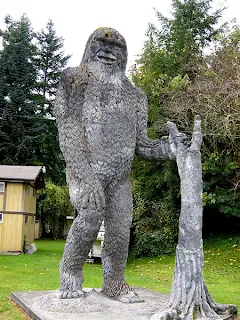Some fantastic genetics news:
Hoax? Viral marketing? or major scientific breakthrough? Texas company DNA Diagnostics, headed by veterinarian Dr. Melba Ketchum, has announced that they have sequenced not one, but three different Sasquatch genomes. Dr. Ketchum has applied for a patent for a method of genetic analysis of wild and domestic animals, which suggests expertise in DNA analysis. Their claim is that not only that the Sasquatch is humanoid, but that they are hybrids between human females and "unknown" male hominins.
“Genetically, the Sasquatch are a human hybrid with unambiguously modern human maternal ancestry. Government at all levels must recognize them as an indigenous people and immediately protect their human and Constitutional rights against those who would see in their physical and cultural differences a ‘license’ to hunt, trap, or kill them."
So not only some amazing claims but a strong message about ethics to go with them.
Over at Teen Skepchick they have dug into the details that are available about Ketchum and Robin Lynne, who put out the press release. It turns out Lynne has made a number of claims about a large Sasquatch family that she has interacted with on her property.
But her evaluation of the evidence is beyond reproach. Apparently she went out one day to her feeding box to find it locked, and when she opened it, the food was gone but there was an opossum inside. She naturally concluded that the Bigfoot family had put the creature in there and locked the box as a joke.Apparently the original manuscript also claimed that they found "angel DNA" in the samples. The more I read the more this sounds like the work of some serious deluded individuals who may have analyzed a sample of wild animal DNA contaminated with human DNA. Or maybe this is truly a history discovery (but I think not).
Image: Bigfoot statue in Silver Lake, Washington. by Plazak on Wikimedia Commons licensed under the Creative Commons Attribution 3.0 Unported license. May not be scientifically accurate.
Now some more realistic science:
Now some more realistic science:
• Human Evolution Enters an Exciting New Phase | Wired Science
I don't think it should be a surprise to anyone that humans are evolving. Evolution is not a ladder where humans have reached the top and will never change again.
I don't think it should be a surprise to anyone that humans are evolving. Evolution is not a ladder where humans have reached the top and will never change again.
But a recent detailed study of 6500 human genomes - Americans of European or African descent - did turn up something unexpected: the explosion of the human population over the past 5000-10000 years has resulted in a "vast abundance of rare genetic variants".
Original paper: Fu, W. et al. "Analysis of 6,515 exomes reveals the recent origin of most human protein-coding variants" Nature Advance online publication, http://dx.doi.org/10.1038/nature11690 (2012).
"... the results suggest that humans are carrying around larger numbers of deleterious mutations than they did a few thousand years ago. But this doesn’t mean that humans now are more susceptible to disease, says Akey. Rather, it suggests that most diseases arecaused by more than one variant, and that diseases could operate through different genetic pathways and mechanisms in different people."One limitation of this study is that it only compared the protein coding sequences of the genomes it analyzed. 98% of our genomes do not encode proteins, so it's possible that whole genome analysis might have told a different story. In fact, I think it would be interesting to compare mutation rates in protein coding and non-coding sequences (some of which is functional, but much of which is junk).
Original paper: Fu, W. et al. "Analysis of 6,515 exomes reveals the recent origin of most human protein-coding variants" Nature Advance online publication, http://dx.doi.org/10.1038/nature11690 (2012).
• Scientists snap a picture of DNA’s double helix for the very first time »
Despite what you might see in science fiction movies and CSI-like TV shows, the DNA double helix is not usually visible under a microscope. In fact Enzo di Fabrizio and his colleagues at the University of Genoa were able to take high resolution photographs of double stranded DNA using an electron microscope in which the DNA double helix is clearly visible.
The image is actually not a single molecule of DNA - it's six DNA molecules wrapped around a seventh, since the energy of the electron beam can break a single DNA molecule. It's hoped that in the future a single DNA molecule can be imaged.
Despite what you might see in science fiction movies and CSI-like TV shows, the DNA double helix is not usually visible under a microscope. In fact Enzo di Fabrizio and his colleagues at the University of Genoa were able to take high resolution photographs of double stranded DNA using an electron microscope in which the DNA double helix is clearly visible.
The image is actually not a single molecule of DNA - it's six DNA molecules wrapped around a seventh, since the energy of the electron beam can break a single DNA molecule. It's hoped that in the future a single DNA molecule can be imaged.
Original paper: Gentile F et al. "Direct Imaging of DNA Fibers: The Visage of Double Helix" Nano Letters Article ASAP (2012)
Image: The famous twists of DNA's double helix have been seen with the aid of an electron microscope and a silicon bed of nails (Image: Enzo di Fabrizio, from Gentile F et al.)
• GATTACA Rises: building structures out of DNA
Last, but not least, a team of French physicists lead by Jean Michel Arbona have designed a new computer model that describes how DNA can fold and knot and weave together into 3-dimensional structures known as DNA origami. See the video here for more details.
Image: The famous twists of DNA's double helix have been seen with the aid of an electron microscope and a silicon bed of nails (Image: Enzo di Fabrizio, from Gentile F et al.)
• GATTACA Rises: building structures out of DNA
Last, but not least, a team of French physicists lead by Jean Michel Arbona have designed a new computer model that describes how DNA can fold and knot and weave together into 3-dimensional structures known as DNA origami. See the video here for more details.









